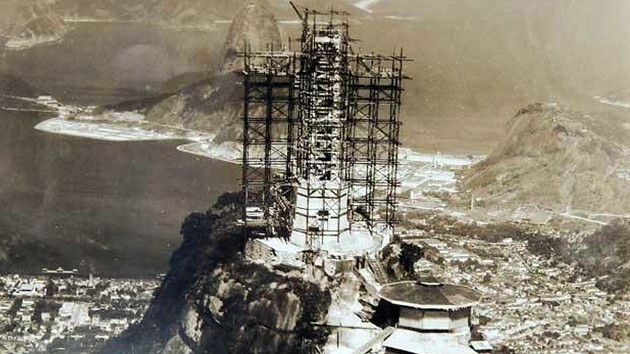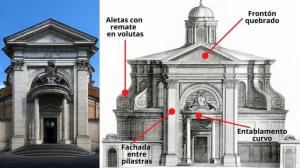Cristo Redentor statue: history, characteristics, meaning and curiosities
In Rio de Janeiro, an emblematic city of Brazil, is the statue of Christ the Redeemer, also known as Christ of Corcovado. The important symbolic value of it has promoted the pilgrimages of the most devout Catholics, but it has also attracted the visit of tourists eager to unveil the mysteries of one of the seven wonders of the modern world.
The image of Jesus Christ crowns the top of Mount Corcovado, located in the Tijuca National Park. The mountain reaches about 710 meters above sea level. There, an 8-meter pedestal supports Christ the Redeemer with its 30.1 meters high and a weight of 1200 tons. From there, Christ watches over the city of Rio de Janeiro and contemplates the Pão de Açúcar mountain.
Characteristics

The work of Christ the Redeemer is conceived as a monumental sculpture in the art deco. This was an eclectic international art style that emerged in the interwar period, that is, between about 1920 and 1939, although it did not have a name until the 1960s. He was very influential in the fine arts, but especially in architecture and applied arts.
As a trend, art deco it was characterized by elegant and sensual refinement; eclectic and historicist language; the use of the straight line; the use of the zigzag and geometric elements, in particular the hexagon, the octagon and the square. Eventually curves and spirals were applied, provided they were subjected to the geometric sense and not to the association with the forms of nature.
In this stylistic context, the statue of the Christ redeemer.

The work, whose structural frame is made of reinforced concrete, is covered by soapstone, a stone also called soap rock due to the malleability of its material. Millions of triangular tesserae were made out of soapstone and combined on the statue's surface to create a cladding.
Iconographically, the work is described as a representation of Jesus Christ with open arms. In his hands, the wounds of the crucifixion are visible, so that it is about the risen Christ, the believer's hope. Above his head, a small crown is glimpsed.
Christ appears dressed in a tunic or dress to the feet, without actually covering them. The tunic is covered by a mantle whose surface and diagonal contrast with the vertical channels formed at the base of it.

The chest of Jesus is slightly exposed, since neither the mantle nor the tunic get to close around the neck. This detail is used to display the heart of Jesus in the entire center of the chest, like a heart that overflows with so much love.
This heart can also be seen from the inside, and it is also covered with soapstone tesserae. The heart has a dimension of 1.30 meters.
It is said that inside the heart, a glass jar houses a parchment with the genealogical trees of Heitor Levy, the master builder, and Pedro Fernandes, a tax engineer.
One of the arms is 40 centimeters shorter than the other to guarantee, like the sails of a ship, that it can withstand winds of 150 km / hour.
Story

The idea of making a monument on top of the Corcovado hill had been born in 1859 by the priest Pierre-Marie Boss. This monument would be, for him, a tribute to the daughter of Emperor Pedro II, Princess Elizabeth. However, it would be a long time before that idea could be realized.
Indeed, it will only be in the 1920s when the Catholic Circle of Rio de Janeiro is ready to fulfill the dream of building a monument on Corcovado. The excuse will be the celebration of the first centenary of the independence of Brazil.
In 1921, the Catholic Church held a competition, which was the winner of the architect Heitor da Silva Costa, inspired by the work of the multifaceted artist Carlos Oswald.
To carry out the project, fundraising activities were carried out and received donations thanks to the entrepreneurial spirit of Cardinal Sebastião Leme, of the Archdiocese of Rio de Janeiro
The work was not worked "in situ" but its parts were commissioned to different artists, some of whom never even visited the monument.
In this way, each part of the sculpture was commissioned to different artists. This is the case of the head and hands, commissioned from the Romanian Gheorghe Leonida and Paul Landowski, a Polish-French artist.
The structure calculations were made by the reinforced concrete specialist, engineer Albert Caquot. Along with Heitor da Silva Costa, supervisor of the entire project, Heitor Levy, his right-hand man, also stood out in the job of master builder.
After five years of construction, the Cristo Redentor or Cristo del Corcovado was inaugurated on October 12, 1931. In 2007 it was chosen as one of the Seven Modern Wonders.
Meaning

Christ the Redeemer is a work whose significance is related to the religious imagination of Brazil. For this country, strongly influenced by Catholicism, Christ is represented as a symbol of redemption, a symbol of forgiveness and a symbol of protection.
Thus, the bodily attitude of the Christ in the statue reflects the welcoming spirit attributed to the figure of Jesus as a bridge between God and humanity, as messiah. But it is also a sign of protection. Christ protects the Carioca people under his arms, like a bird that gathers its chicks under his wings.
At the same time, the statue seems to receive the visitor to the city, in a double gesture of welcoming and showing the Rio de Janeiro landscape.
The disposition of Christ the redeemer before the city makes us think, finally, of the idea of an offering people that prostrates themselves at the feet of their only savior. The redeeming Christ is, then, the offering that seals a covenant between the people and their God.
Christ the Redeemer lightning rod

The monument's location and characteristics make it a target of lightning when tropical storms strike. Therefore, to care for and protect the monument, a series of lightning rods have been installed in the most exposed points of the statue, such as the head and arms.
While it is true that this does not prevent damage, it minimizes the impact. For this reason, those who guard the monument have a reserve of soapstone rock to rebuild the affected sectors during electrical storms.
Curiosities about Christ the Redeemer
- Before being called Mount Corcovado, the hill was called by the 16th century Portuguese "Pico de la Tentación", alluding to the passage of the temptations of the desert of Jesus.
- Before its construction, Mount Corcovado already had a viewpoint at the top. For this reason, the train that takes visitors on existed since 1884, which facilitated the process of transfers during the construction period.
- The head is made up of 50 different pieces, all of them made in France.
- It began to be assembled from the head.
- No worker died during the construction of the monument, a striking phenomenon at the time.
- The structure is hollow inside. However, getting in is very difficult. It is necessary to request the authorization of the Metropolitan Curia of Rio de Janeiro.



